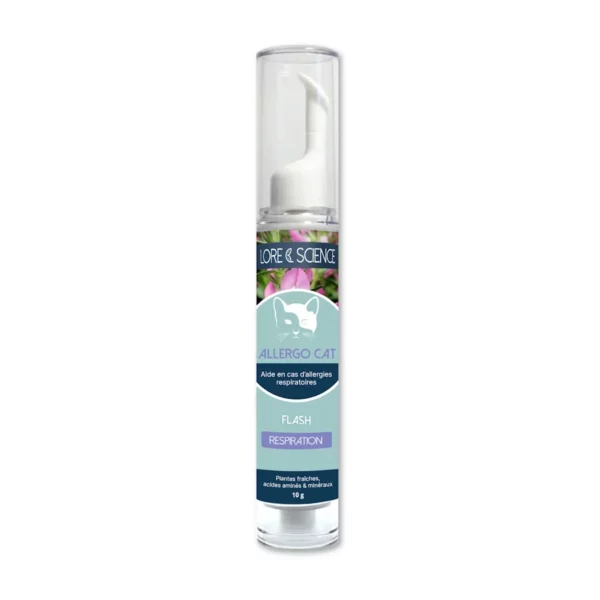Cats are sensitive animals and can be prone to a variety of allergies, which can lead to unpleasant symptoms and disrupt their quality of life. As in humans, feline allergies arereactions of the body's excessive defenses against substances it is theoretically able to tolerate. In this article, Lore & Science explains the different types of allergy in cats, their symptoms, causes and possible treatments.
The different types of cat allergy
It should be noted that there are several types of allergy in cats, each with different causes and symptoms. Cat owners need to be aware of the different types of allergy so they can detect symptoms and obtain appropriate treatment. There are 4 main categories of allergy.
First of all, food allergies. This is one of the most common types of feline allergy. Cats can be allergic to any type of food, but the most common allergens are beef, fish, dairy products and cereals. Symptoms of food allergy in cats can include vomiting, diarrhea, itching and weight loss. Fortunately, they are easily treated by eliminating the allergenic food from the animal's diet.
Contact allergies are another common form of allergy in cats. They are caused by contact with irritating substances such as cleaning products, carpets, blankets, shampoos or cosmetics. Symptoms can include itching, rashes and skin infections. The key is to identify the allergen and remove it from your pet's environment.
The third major category is respiratory allergies. These can be caused by allergens such as dust, dust mites, pollen or cigarette smoke. They are generally identified by sneezing, itching, coughing and wheezing.
Finally, flea-bite allergies are the last common form of allergy in cats. They are actually caused by flea saliva when they bite the cat's skin. They are responsible for itching, redness, rashes and skin infections.
In any case, you should be aware that some cats can suffer from several types of allergy at the same time. It's therefore essential to keep a close eye on your cat's symptoms, and to consult your vet for a precise diagnosis and appropriate treatment in case of suspicion.
Allergy symptoms in cats
Allergy symptoms in cats can be very diverse, depending on the type of allergy and the severity of the reaction. Indeed, cats often present different clinical signs from dogs or humans, sometimes making diagnosis more difficult. Particular attention must therefore be paid to unusual behavior.
Itching
Itching is one of the most common symptoms of allergies in cats. Cats may frequently scratch, bite or lick their skin and hair to relieve themselves. This can lead to skin lesions such as scabs, sores or areas of bare skin. Cats may also scratch their face or ears, which can lead to abrasions and irritation.
Similarly, the animal's skin may be reddened, with areas of bare skin or lesions. Allergic dermatitis can affect any part of the cat's body, but is often localized to the neck, head, ears and base of the tail.
Breathing difficulties
Sneezing andrunny nose are common symptoms in cats suffering from respiratory allergies. The cat or kitten may also present flu-like symptoms, such as a dry cough andwheezing. Asthma attacks should also alert you.
Gastrointestinal problems
Food allergies can lead to gastrointestinal symptoms such as vomiting and diarrhea. The cat may also lose weight and lack appetite. These allergies are difficult to diagnose, as gastrointestinal symptoms can also be caused by other illnesses.
Furthermore, it's important to note that allergy symptoms in cats can be exacerbated by secondary infections, such as bacterial or fungal skin infections, which can occur when the skin is constantly irritated by itching. Early diagnosis and treatment are therefore essential to avoid complications.

Causes of cat allergies
The study of the causes of allergies in cats is still an evolving field of research, but some leads are being put forward by veterinary specialists. Allergies may be linked to genetic predisposition. Research has also shown that certain breeds of cat, such as Siamese or Persian, are more likely to develop allergies than others.
In addition to genetic factors,excessive exposure to allergens is also a key factor in the development of these feline allergies. The most common include dust, dust mites, pollen, mold and cigarette smoke. Our companions are exposed to these allergens in their domestic environment, but also outdoors, for those of our pets who are used to going outside.
On the other hand, an inadequate or poorly balanced diet can weaken a cat's immune system, making it more susceptible to developing allergies. Industrial foods containing artificial colors, preservatives or flavors can be an additional risk factor.
Finally, skin conditions of bacterial or fungal origin can make a cat's skin more sensitive to allergens. Irritating or toxic chemicals in the environment can also contribute to the development of allergies by affecting the skin and immune system.
Of course, the causes of allergies in cats vary from one animal to another. Veterinary specialists recommend consulting a doctor as soon as the first symptoms of allergy appear, so that the exact cause can be quickly determined and appropriate treatment put in place.
Treatments for cat allergies
Treatment of cat allergies depends on the type and severity of the allergy. Here are some common treatment options:
- Antihistamines: these medications can help relieve mild to moderate allergy symptoms, such as itching and sneezing.
- Corticosteroids: these anti-inflammatories can be administered orally, by injection or topically to treat more severe allergies.
- Immunotherapy: also known as desensitization, this involves the progressive administration of a small amount of allergen to help the cat develop tolerance.
- Hypoallergenic diets: these dietary adaptations can help reduce allergic reactions in some cats.
- Topical treatments: shampoos and sprays can help reduce skin allergy symptoms.
Environmental management In some cases, the best way to treat allergies in cats is to limit their exposure to the allergen in question. This may involve diet changes, the use of air filters or other measures to reduce the presence of the allergen in the cat's environment.
Fresh medicinal plants: their clinically proven efficacy enables us to act quickly on a daily basis to improve the quality of life of our little companions. At Lore & Science, we offerAllergo Cat herbal support to relieve allergies and respiratory problems in felines.
Feline allergies: finding the cause to treat it properly
As you can see, it's important to consult a veterinarian if you suspect your cat is suffering from allergies. He or she can then carry out tests to determine the allergen responsible and recommend the most appropriate treatment for your cat. In addition, he or she will monitor your pet's general health to ensure that allergies are not causing other complications, such as ear infections or respiratory problems.
Do you have questions about treating and preventing allergies in your cat? Ask us in comments ↓
















